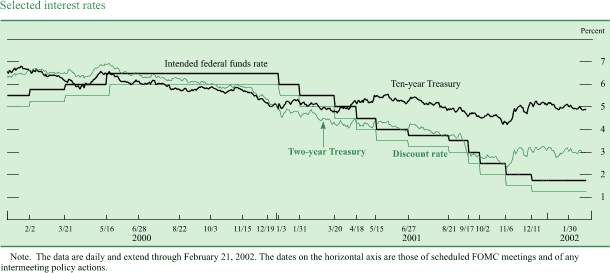|
After the terrorist attacks on September 11, the
available Committee members held a telephone
conference on September 13, during which they agreed
that the financial markets were too disrupted to allow
for an immediate alteration in the stance of monetary
policy. However, the members were in agreement that
the attacks' potential effects on asset prices and on the
performance of the economy, and the resulting
uncertainty, would likely warrant some policy easing in
the very near future. Accordingly, the FOMC, at a
telephone conference on September 17, voted to
reduce its target for the federal funds rate 1/2
percentage point, to 3 percent, and stated that it
continued to judge the risks to the outlook to be
weighted toward economic weakness.
Over subsequent weeks, heightened aversion to risk,
which caused investors to flock from private to
Treasury and federal agency debt, boosted risk
spreads sharply, especially on lower-rated corporate
debt. Increased demand for safe and liquid assets
contributed to selling pressure in the stock market. At
its October 2 meeting, the FOMC had little hard
information available on economic developments since
the attacks. However, evidence gleaned from surveys,
anecdotes, and market contacts indicated that the
events of September 11 had considerable adverse
repercussions on an already weak economy: Survey
indicators of consumer confidence had fallen, and
consumer spending had apparently declined. At the
same time, anecdotal information pointed to additional
deep cutbacks in capital spending by many firms after
an already-significant contraction in business fixed
investment over the summer months.
When the FOMC met on November 6, scattered early
data tended to confirm the information that the decline
in production, employment, and final demand had
steepened after the terrorist attacks. Although an
economic turnaround beginning in the first half of 2002
was a reasonable expectation according to the
Committee, concrete evidence that the economy was
stabilizing had yet to emerge. Meanwhile, the marked
decrease in energy prices since the spring had induced
a decline in overall price inflation, and inflation
expectations had fallen. Accordingly, the FOMC voted
to lower its target for the federal funds rate 1/2
percentage point at both its October and November
meetings and reiterated its view that the risks to the
outlook were weighted toward economic weakness.
The sizable adjustments in the stance of monetary
policy in part reflected concerns that insufficient policy
stimulus posed an unacceptably high risk of a more
extended cyclical retrenchment that could prove
progressively more difficult to counter, given that the
federal funds rate--at 2 percent--was already at such a
low level.
By the time of the December FOMC meeting, the most
recent data were suggesting that the rate of economic
decline might be moderating. After plunging earlier in
the year, orders and shipments of nondefense capital
goods had turned up early in the fourth quarter, and the
most recent survey evidence for manufacturing also
suggested that some expansion in that sector's activity
might be in the offing. In the household sector, personal
consumption expenditures appeared to have been quite
well maintained, an outcome that reflected the
continuation of zero-rate financing packages offered by
the automakers, widespread price discounting, and low
interest rates. In an environment of very low mortgage
interest rates, household demand for housing remained
at a relatively high level, and financial resources freed
up by a rapid pace of mortgage refinancing activity also
supported consumer spending.
Nonetheless, the evidence of emerging stabilization in
the economy was quite tentative and limited, and the
Committee saw subpar economic performance as likely
to persist over the near term. Moreover, in the
probable absence of significant inflationary pressures
for some time, a modest easing action could be
reversed in a timely manner if it turned out not to be
needed. In view of these considerations, the FOMC
lowered its target for the federal funds rate 1/4
percentage point, to 1-3/4 percent, on December 11,
2001, and stated that it continued to judge the risks to
the outlook to be weighted mainly toward economic
weakness. As had been the case throughout the year,
the Board of Governors approved reductions in the
discount rate that matched the FOMC's cuts in the
target federal funds rate, bringing the discount rate to
1-1/4 percent, its lowest level since 1948.
Subsequent news on economic activity bolstered the
view that the economy was beginning to stabilize. The
information reviewed at the January 29-30, 2002,
FOMC meeting indicated that consumer spending had
held up remarkably well, investment orders had firmed
further, and the rate of decline in manufacturing
production had lessened toward the end of 2001. With
weakness in business activity abating, and monetary
policy already having been eased substantially, the
FOMC left the federal funds rate unchanged at the
close of its meeting, but it continued to see the risks to
the outlook as weighted mainly toward economic
weakness.
|

